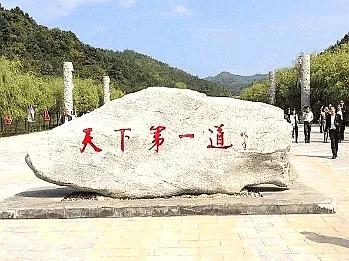Qin Shi Huang's Qin Straight Road, why didn't the grass grow for more than two thousand years? Expert: This is the conscience project! Why didn't the road built by Qin Shi Huang grow grass for more than two thousand years? Expert: Dig it out and see!
In China's more than two thousand years of imperial history, Yingzheng was a strong man who did great things and could achieve things: Yinzheng was born in Handan, the capital of the Zhao state, and later returned to the Qin state. He took the throne at the age of 13, and at the age of 22, he quelled the rebellion of the Marquis of Changxin, and then eliminated the powerful minister Lü Buwei and began to monopolize the government. After pro-government, he reused Li Si, Wang Qi and others, and spent nearly 10 years successively destroying the six kingdoms of Han, Zhao, Wei, Chu, Yan, and Qi, completing the great cause of unifying China and establishing a centralized and unified multi-ethnic state, the Qin Dynasty. As a result, Yingzheng became the first monarch on the mainland to have the title of "Emperor", and was the first emperor of Qin.
After Qin Shi Huang unified the world, he abolished the sub-feudal system and replaced it with a county system; At the same time, the book is the same text, the car is on the same track, and the weights and measures are unified. Attacking the Xiongnu in the north, conquering Baiyue in the south, and building the Great Wall; Build a spiritual canal to connect the Yangtze river and the Pearl River system. In Qin Shi Huang's "Great Construction", in addition to the legendary Afang Palace and the great wall that stands for thousands of miles, there is also a huge project, that is, the construction of the Qin Dynasty's highway - Qin Straight Road.

Ruins of Qin Zhidao
Abolish the sub-feudal system and replace it with a county system; At the same time, the book is the same text, the car is on the same track, and the weights and measures are unified. Attacking the Xiongnu in the north and attacking the Xiongnu in the south, the Great Wall of Ten Thousand Miles was built to defend against foreign invasions, and the Great Wall of Qin did play a role in resisting the enemy, as Jia Yi said in the "Theory of Passing qin": "(The Great Wall) is more than seven hundred miles of the Xiongnu, the Hu people do not dare to go south and herd horses, and the soldiers do not dare to bend their bows and complain." ”
Qin Straight
Similar to the Great Wall, the construction of the Qin Straight Road also had a very clear military purpose - to prevent and prevent the invasion of the Xiongnu nobles in the northern kingdom. In the thirty-fifth year of Qin Shi Huang (212 BC), Qin Shi Huang ordered the general Meng Tian to lead a 300,000-strong army to build a military passage of more than 700 kilometers from north to south of Linguang Palace in Shaanxi province in the south and Jiuyuan County in Baotou, Inner Mongolia in the north to the present.

In addition, there are many theories about the purpose of building the Qin Straight Road, in addition to "as a channel for transporting troops", the more popular sayings include "for the convenience of patrol" and "as a transportation route". No matter what qin shi huang's original intention was, the high-speed and convenient transportation function of the Qin Straight Road, after its completion, the Qin Straight Road, from the fall of the Qin Dynasty to the Qing Dynasty, was used by various dynasties, and played a rather huge role in history.
According to legend, Qin Shi Huang had very high requirements for this road. In addition to being wide and flat, it is also required that rainy days should not become soft and grass should never grow. The Shi Huang would have such a request, which was probably related to his beautiful idea that the Qin Dynasty would be passed down from generation to generation until thousands of generations.
But at a time when there was no concrete, this was undoubtedly a great challenge to the craftsman's technology. In the beginning, the craftsmen in charge of the construction were very difficult, but after studying the ancient books and trial and error, the craftsmen really found a solution - that is, to thoroughly roast the soil that built the road, or to burn it and mix it with salt and alkali. As a result, the road is hard, and the soil has been artificially changed, resulting in no vegetation. Recent archaeological excavations have also confirmed this.
The construction of the Qin Straight Road allows us to glimpse the diligence and wisdom of the ancient working people on the mainland. Little by little, they have forged this great project that has been admired by the world under the condition of relying on manpower and simple tools. After its completion, the Qin Straight Road was used before the Qing Dynasty, and was gradually abandoned by the Qing Dynasty. In the 1970s, the archaeological community revived the study of qin straights. In 2006 and 2013, the Qinzhidao Site, the Qinzhidao Starting Point Site, the Yan'an Section of the Qinzhidao Ruins, and the Qingyang Section of the Qinzhidao Ruins were listed in the sixth and seventh batches of national key cultural relics protection units, respectively.